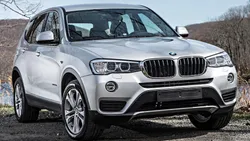

BMW X3 Generation 2 F25 Facelift 2014 Details
Explore the BMW X3 generation, specifically the BMW X3 generation 2 F25 facelift from 2014. Discover its specifications, features, and performance aspects throughout Portugal.
The BMW X3 has built its reputation as a versatile luxury compact SUV that combines performance, comfort, and utility. The second generation, dubbed F25, introduced several enhancements when it was laun...
Technical Specifications
Select Version
Dimensions
Engine
Driving
Others
History and Features
Mycarro AI
Apr 26, 2025
The BMW X3 has built its reputation as a versatile luxury compact SUV that combines performance, comfort, and utility. The second generation, dubbed F25, introduced several enhancements when it was launched in 2010, marking a significant evolution in BMW's ongoing journey in the SUV market. However, in 2014, a notable facelift rejuvenated this model, bringing with it a host of updates that emphasized not just aesthetics but also performance and technology.
Design and Exterior Enhancements
The facelifted BMW X3 F25 received subtle design changes that elevated its visual appeal. The front fascia was refreshed with newly designed headlights that incorporated LED technology, giving the vehicle a more modern and aggressive look. Additionally, the kidney grille was slightly enlarged, imparting a bolder stance. The lower bumper was redesigned to enhance aerodynamics and present a sportier appearance.
Along the sides, the aesthetics were complemented by new alloy wheel designs, which varied in size and style depending on the trim levels chosen. The rear section reflected the changes up front, with updated taillights that featured LED technology, contributing not only to style but also to visibility. Overall, the facelift made the F25 more visually compelling without straying too far from its predecessor's design language.
Interior and Technology Upgrades
In the interior, BMW implemented several improvements aimed at enhancing passenger comfort and convenience. Higher-quality materials were used throughout the cabin, resulting in a more luxurious feel. The layout remained user-friendly, but the center console was equipped with a revamped infotainment system, featuring the latest iteration of BMW's iDrive technology. This upgrade included a more responsive touchscreen and improved voice command features, making it easier for drivers to access navigation, entertainment, and communication while on the move.
Moreover, the seating configuration continued to offer ample rear-seat legroom and cargo space, ensuring that the practicality of the X3 was not compromised. Optional features such as upgraded leather upholstery and a panoramic sunroof were also available, catering to those seeking a more premium experience within their SUV.
Performance and Handling
Under the hood, the BMW X3 F25 facelift brought enhancements to its engine lineup. The updated models included more fuel-efficient engines and offered a balance between power and performance. Engine options ranged from turbocharged four-cylinder units to inline-six engines, all designed to provide a dynamic driving experience that BMW is renowned for.
Additionally, the facelift offered an improved version of BMW's xDrive all-wheel-drive system, which ensured that the X3 maintained its agility on varied terrains, enhancing both handling and stability. With an emphasis on a sporty drive, the vehicle's suspension was fine-tuned to better absorb road imperfections while still delivering a satisfying connection to the road.
Safety and Driving Assistance Technologies
Safety remained a priority in the updated BMW X3, with the introduction of multiple advanced driving assistance systems. Optional features included adaptive cruise control, lane departure warning, and forward collision warning with automatic emergency braking. These technologies aimed to bolster the vehicle's safety credentials and provided peace of mind for drivers and passengers.
Market Reception and Competitors
Upon its release, the facelifted BMW X3 F25 received positive reviews from critics and consumers alike. Its combination of luxury, practicality, and performance appealed to a wide range of customers. Competing against other luxury compact SUVs such as the Audi Q5 and Mercedes-Benz GLC, the X3 managed to carve out a niche for itself due to its driving dynamics and brand prestige.
Conclusion
The BMW X3 Generation 2 (F25), particularly the 2014 facelift, successfully revitalized an already strong contender in the luxury compact SUV segment. By refining its design, enhancing its technology, and prioritizing performance, BMW managed to elevate the X3 further while maintaining the essence that its enthusiasts love. With its blend of sportiness and practicality, the X3 remains a versatile option for those looking to engage in an active lifestyle without sacrificing luxury.
